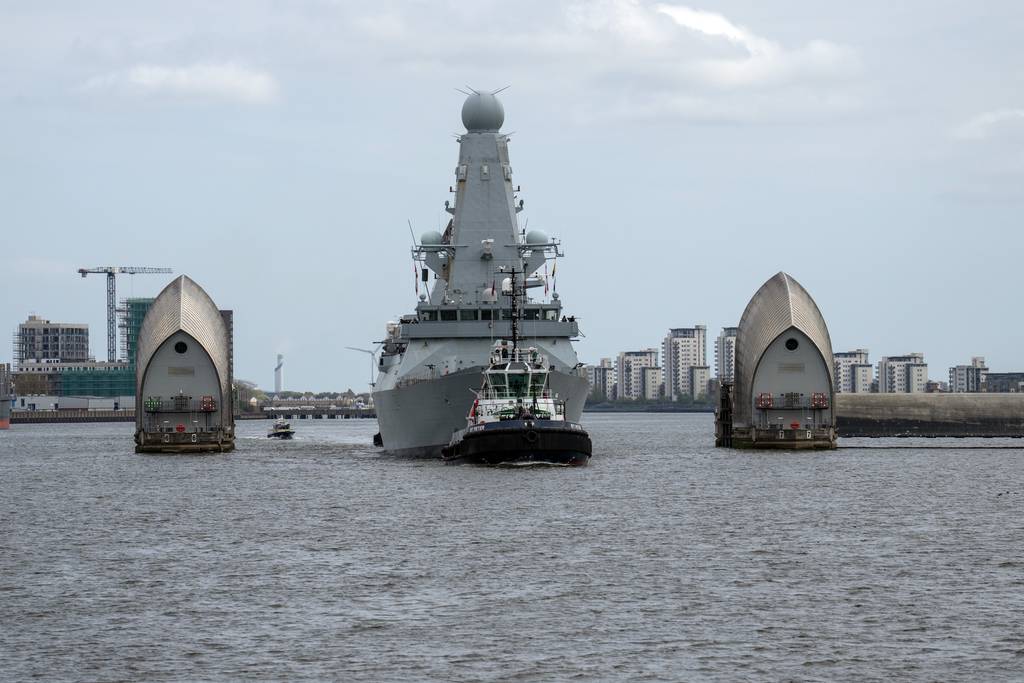
PARIS — The U.K. government awarded pan-European missile maker MBDA three contracts worth a total £405 million ($515 million) to bolster the Royal Navy’s defenses against anti-ship ballistic missiles.
Two contracts are to upgrade the Aster 30 missiles onboard the service’s six Type 45 destroyers with upgraded warheads and new guidance and seeker software to defeat ballistic missiles, the Ministry of Defence said in a statement on Jan. 21. The third contract covers in-service support for the Navy’s Sea Viper air-defense system for the next five years.
The planned upgrade comes as navies face growing missile and drone threats to their surface fleets. In the Red Sea, where the U.K.’s HMS Diamond is patrolling alongside warships from countries including the U.S. and France, Yemen’s Iran-backed Houthis have used cruise and ballistic anti-ship missiles as well as drones to target vessels.
“As the situation in the Middle East worsens, it is vital that we adapt to keep the UK, our allies and partners safe,” Defence Secretary Grant Shapps said in a statement. “Sea Viper has been at the forefront of this, being the Navy’s weapon of choice in the first shooting down of an aerial threat in more than 30 years.”
The Diamond, a Type 45 destroyer, this month used its Aster missiles to destroy multiple incoming attack drones, after having already shot down threatening drones in December. The Sea Viper weapons system, which includes the Aster missiles, has been in service with the Royal Navy for more than a decade, and can eliminate threats when they close to around 70 miles.
MBDA, the prime contractor for the Sea Viper system, will work with BAE Systems to upgrade the radar onboard the Type 45 destroyers. The upgrade to the Type 45 fleet is expected to reach full operational capability by autumn of 2032, the ministry said.
Navies are racing to shore up their shipborne air defenses as faster and more capable anti-ship cruise and ballistic missiles proliferate among both states and non-state actors, analysts at the International Institute for Strategic Studies wrote in November. A third of Europe’s maritime surface-to-air missile capabilities are modern, with the remainder aging or outdated, according to the think tank.
France and Italy in January last year announced the purchase of nearly 700 additional Aster missiles for both ground-based and maritime air defense, including the upgraded Block 1 version. Aster missiles equip both countries’ multi-role frigates and SAMP/T air-defense systems.
The Royal Navy, French Navy and Italian Navy in a NATO exercise in June used Aster 30 missiles to destroy supersonic and subsonic sea-skimming and maneuvering targets.
The upgraded Aster Block 1 missiles can destroy ballistic threats with a 600-kilometer range, according to MBDA. France and Italy started work in 2016 on a Block 1 New Technology version with a new seeker designed to cover ballistic threats with a longer range and separable warheads.
In the next stage of the Sea Viper evolution, the U.K. will evaluate the introduction of the NT missile, which would “even further enhance the ballistic missile defense capabilities of the U.K.’s Type 45 destroyers,” the ministry said.
France in 2020 and Italy and the U.K. in 2021 signed contracts for a midlife upgrade of their existing Aster missiles, with a total value for the upgrade program of more than €1.2 billion.
The three contracts will sustain 350 jobs in the U.K., and will involve MBDA employees across the U.K., France and Italy, as well as colleagues from BAE Systems, the ministry said.
Rudy Ruitenberg is a Europe correspondent for Defense News. He started his career at Bloomberg News and has experience reporting on technology, commodity markets and politics.
- SEO Powered Content & PR Distribution. Get Amplified Today.
- PlatoData.Network Vertical Generative Ai. Empower Yourself. Access Here.
- PlatoAiStream. Web3 Intelligence. Knowledge Amplified. Access Here.
- PlatoESG. Carbon, CleanTech, Energy, Environment, Solar, Waste Management. Access Here.
- PlatoHealth. Biotech and Clinical Trials Intelligence. Access Here.
- Source: https://www.defensenews.com/global/europe/2024/01/22/uk-moves-to-boost-warship-protections-against-ballistic-missiles/
- :has
- :is
- :where
- $UP
- 1
- 2020
- 2021
- 30
- 350
- 70
- 700
- 8
- a
- According
- across
- actors
- adapt
- Additional
- After
- against
- Aging
- AIR
- alongside
- already
- among
- an
- Analysts
- and
- announced
- ARE
- around
- AS
- At
- attack
- awarded
- BAE Systems
- been
- being
- Billion
- Block
- Bloomberg
- bolster
- boost
- both
- by
- CAN
- capabilities
- capability
- capable
- Career
- choice
- Close
- colleagues
- comes
- commodity
- contract
- Contractor
- contracts
- countries
- cover
- covers
- cruise
- decade
- December
- defence
- Defense
- designed
- destroy
- Diamond
- down
- drone
- Drones
- East
- eliminate
- employees
- enhance
- Europe
- Europes
- evaluate
- evolution
- Exercise
- existing
- expected
- experience
- Face
- faster
- First
- five
- FLEET
- For
- forefront
- France
- French
- from
- full
- further
- Government
- grant
- Growing
- guidance
- Have
- having
- he
- his
- HTTPS
- images
- in
- includes
- Including
- Incoming
- Institute
- International
- Introduction
- involve
- IT
- Italian
- Italy
- ITS
- Jan
- January
- Jobs
- jpg
- june
- Keep
- Last
- Last Year
- longer
- maker
- Maritime
- Markets
- Middle
- Middle East
- million
- ministry
- missiles
- Modern
- Month
- more
- moves
- multiple
- nearly
- New
- news
- next
- nt
- of
- on
- Onboard
- operational
- or
- our
- partners
- planned
- plato
- Plato Data Intelligence
- PlatoData
- politics
- Prime
- Program
- purchase
- racing
- radar
- range
- reach
- Red
- remainder
- Reporting
- royal
- s
- safe
- Said
- SEA
- secretary
- service
- shooting
- shot
- signed
- situation
- SIX
- Software
- Stage
- started
- Statement
- States
- Strategic
- supersonic
- support
- Surface
- system
- Systems
- tank
- Target
- targets
- Technology
- than
- that
- The
- the UK
- their
- they
- think
- think tank
- Third
- this
- threat
- threats
- three
- to
- Total
- type
- U.K.
- U.K. government
- u.s.
- Uk
- upgrade
- upgraded
- used
- value
- version
- vessels
- vital
- we
- Weapons
- WELL
- when
- which
- will
- with
- Work
- worth
- would
- year
- years
- zephyrnet












